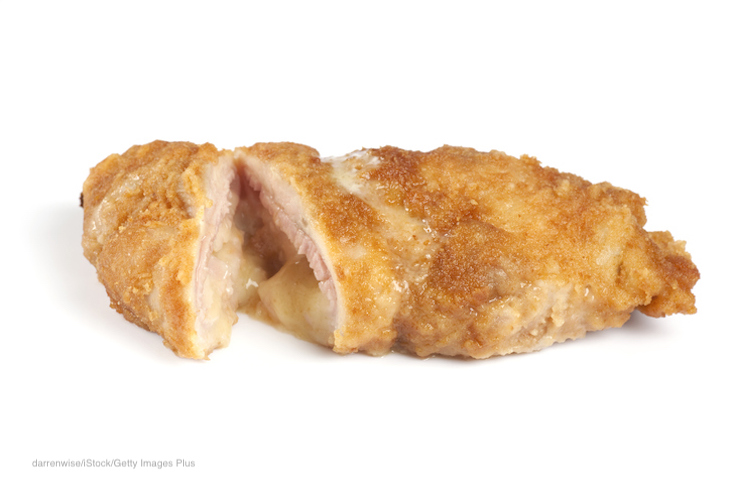A new Salmonella outbreak that has sickened at least 17 people is linked to frozen raw breaded stuffed chicken breasts. Sixty-two percent of these patients have been hospitalized because they are so sick. And unfortunately, this is not the first time a serious outbreak has been linked to these types of products. How should you handle and cook frozen raw breaded stuffed chicken?

In Canada in 2018 and 2019, almost 600 people were sickened by a Salmonella outbreak linked to frozen raw breaded chicken. Also in 2018, an outbreak in the U.S. was linked to Ruby’s Pantry frozen breaded raw chicken. In 2015, two outbreaks linked to these products that were made by Aspen Foods and Barber Foods sickened at least 20 people in the United States. And remember that in Salmonella outbreaks, case counts are notoriously underreported because most people who contract this illness do not go to a doctor. The multiplier for these outbreaks is around 30.
First, it’s important to mention that no company is allowed to sell food products that are contaminated with such a high pathogenic load that they make people sick. This is not blaming consumers for getting sick. Unfortunately, it’s a fact of life that this happens, and consumers have to learn how to protect themselves.
So what is it about frozen raw breaded chicken products, stuffed or unstuffed, that is so problematic? There are several factors that play into these outbreaks.
First, it’s a fact that most chicken products are contaminated with Salmonella or other types of bacteria. All chicken should be handled carefully to prevent illness, but many people don’t know that.
Second, the entire product, from the chicken to the stuffing to the breading, can be contaminated with pathogens. The chicken can usually be thoroughly cooked using conventional methods, but the stuffing may not be heated to the safe temperature of 165°F in the middle, so bacteria can survive. And the breading can fall off and contaminate other foods or surfaces in the kitchen.
Third, these products can look cooked even if they are not, so some consumers may think they are just reheating the chicken, when they instead are cooking a raw product. The products are often pre-browned. In interviews, some of the patients told investigators that the chicken they ate was undercooked and did not use a food thermometer to check the temperature.
And fourth, the way these products are sometimes cooked can be problematic. Microwave cooking is especially risky, since those ovens can have cold spots where food may not be heated to safe temperatures. You should also not use an air fryer when cooking these chicken items. Even using a thermometer correctly can miss spots that are undercooked. Bacteria can survive and can make you sick. In the current outbreak, some patients said they used the microwave to cook the items.
So how do you handle and cook frozen raw breaded chicken products, stuffed or unstuffed? Here are a few rules to follow.
First, wash your hands often! Wash them thoroughly with soap and water before you start cooking, after you have touched the product, and after cleaning up.
Second, carefully read the package instructions every time you make these products. They will tell you the temperature to use to cook the chicken, how long to cook it, and how to test for doneness. Always use a reliable food thermometer every time, and insert it correctly into the product.
Third, do not use the microwave oven to cook these products. This cooking method works well for some foods, but not for raw chicken products.
Fourth, watch out for dropped crumbs that can cause cross-contamination. Open the packages carefully and make sure that bread crumbs do not scatter around your kitchen. If they do, clean the area with soap and water. Clean utensils, cutting boards, plates, and countertops with soap and water after you prepare these products.
And fifth, cook these products to 165°F, as checked with a food thermometer, every time. Insert the probe into several areas of the chicken, washing the probe after each check. Do not eat these products if that temperature has not been reached; return them to the oven until they are thoroughly cooked.
Finally, stay aware of recalls and outbreak announcements. If you have recalled products in your home, do not prepare and eat them. It’s better to be safe than sorry. And if you do get sick with the symptoms of food poisoning, call your doctor.

If you or a loved one have been sickened with a Salmonella infection after eating raw frozen breaded chicken products, please contact our experienced lawyers for help at 1-888-377-8900 or 612-338-0202.




